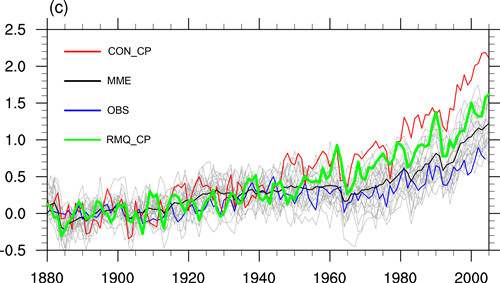Unrealistic treatment of detrained water substance in FGOALS-s2 and its influence on the model’s climate sensitivity
Date:2016-03-07
Based on a series of aqua-planet and air–sea coupled experiments, the influence of unrealistic treatment of water substance in FGOALS-s2 on the model’s climate sensitivity was investigated in a recent paper published in Atmospheric and Oceanic Science Letters (He, 2016). Because the model does not adopt an explicit microphysics scheme, the detrained water substance from the convection scheme is converted back to humidity. This procedure can lead to an additional increase in water vapor in the atmosphere, which can strengthen the model’s climate sensitivity (CON_CP in Figure 1, below). Further sensitivity experiments confirm this deduction. After removing the water vapor converted from the detrained water substance, the water vapor reduced significantly in the upper troposphere, and the high clouds also reduced. Quantitative calculations show that the water vapor reduced by almost 10% of the total water vapor, and 50% at 150 hPa, when the detrained water substance was removed, contributing to a 30% atmospheric surface temperature increase (RMQ_CP in Figure 1). This study calls for an explicit microphysics scheme to be introduced into the model in order to handle the detrained water vapor and thus improve the model’s simulation skill.

Figure 1 Time series of the annual mean global atmospheric surface temperature(units: °C) anomaly (relative to the first 30 years) simulated by CON_CP, the multi-model ensemble (MME), RMQ_CP, and that observed (OBS).
Reference
He, B.. 2016. "Unrealistic treatment of detrained water substance in FGOALS-s2 and its influence on the model’s climate sensitivity." Atmospheric and Oceanic Science Letters 9(1): 45–51.
http://www.tandfonline.com/doi/abs/10.1080/16742834.2015.1124601
